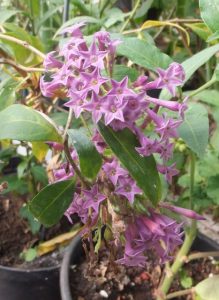
And the Latin Cestrum is hardly any better. Anyway these scented plants are well suited to greenhouses and conservatories though sadly soon grow too large to be generally popular as house plants. Not quite hardy some have tried these outdoors as wall shrubs but they don’t survive long whereas under glass they can live for decades.
From South America and Caribbean these evergreen (and some deciduous) shrubs in the Potato family were introduced in the late Eighteenth century as good subjects for the new hot houses. Paxton listed over three dozen species in 1868, remarking these were “of easy culture” though rather scathingly also adds “a genus of little beauty”.

To be fair they’re not often grown for their beauty as decorative shrubs though actually pretty enough, and some can be in bloom for most of the year. It is for their scent from the sprays of tubular flowers they’re wanted, it’s especially strong in the evenings. And as these are vigorous and recover well you can also take some as cut flowers.
You could as usual start from seed but of course named varieties are better and not expensive as small plants, then easily multiplied by cuttings. As these start flowering when still compact a plant can be grown till too large then given to a friend and replaced with a newer specimen. Though you can instead prune back hard after flowering. You might then root the trimmings as cuttings to give friends instead, for be sure they will want one.
Cestrums enjoy a well drained gritty compost with plenty of leaf mould. As always generous containers would give happier plants, but which will then grow larger too rapidly. Slightly smaller tubs serve as Cestrums can still bloom well if Rose type fertiliser is added to their water throughout the growing season.

My favourite though not the strongest scented is the most attractive and relatively compact Cretan Purple featured. This is a cross between the tall C. parqui with yellowish flowers and the equally vigorous red flowered C. purpureum / elegans, which are also available. Another excellent choice is the creamy green flowered Night Jessamine C. nocturne.


